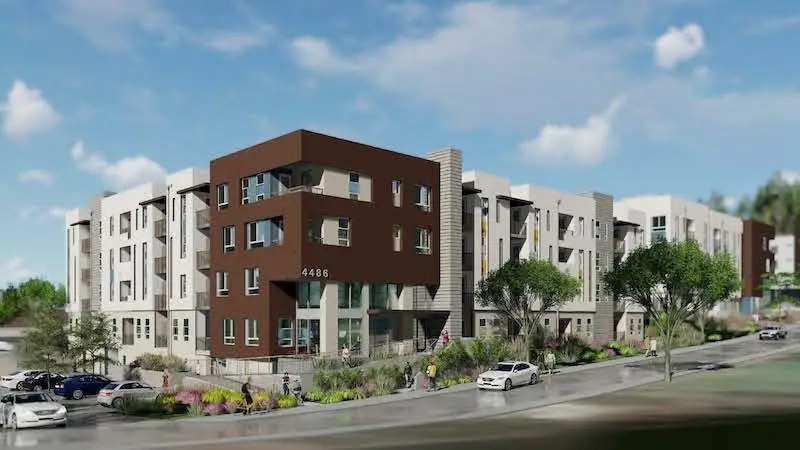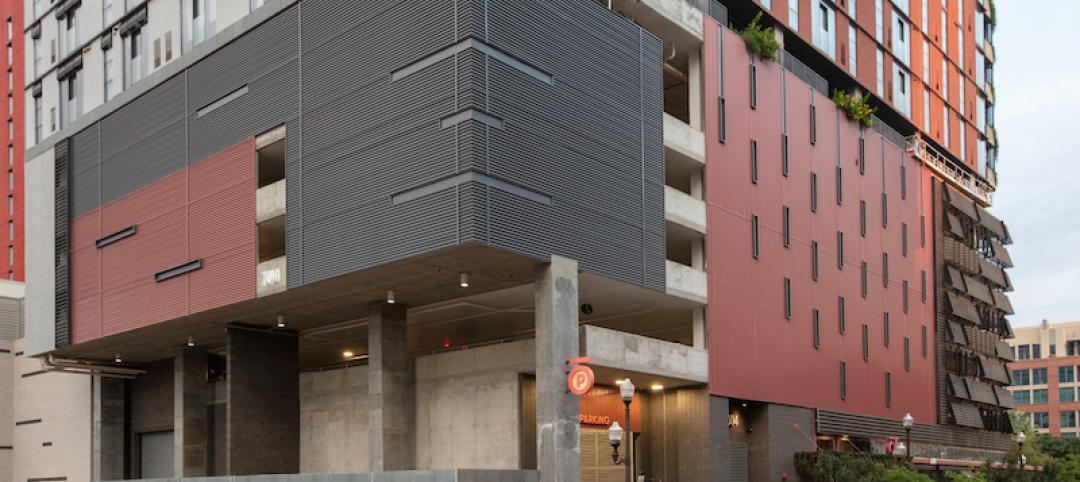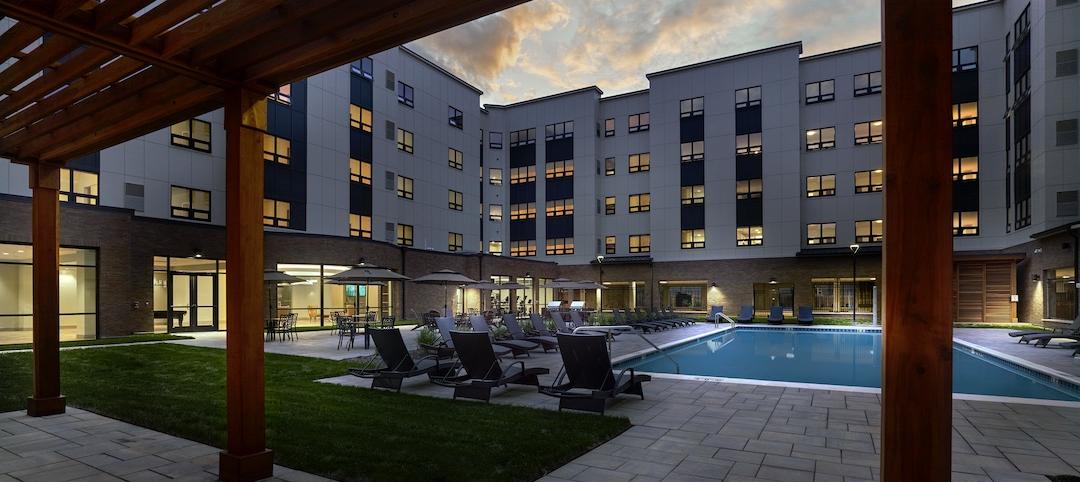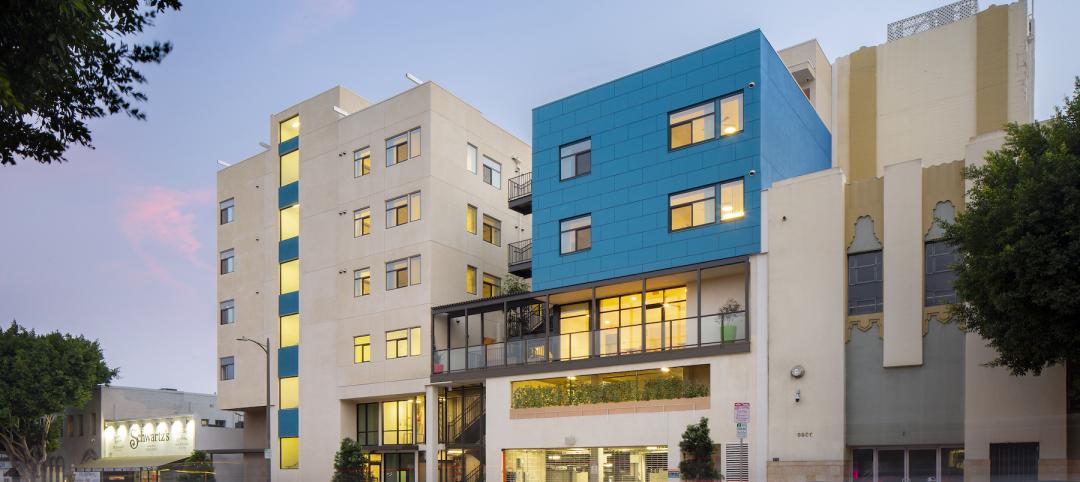Built in 1942, Rose Hill Courts is one of Los Angeles’ oldest public housing complexes. And led by a team that includes the Housing Authority of the City of Los Angeles (HACLA), the developer Related California, and the general contractor R.D. Olson Construction, the first phase of Rose Hill Courts’ redevelopment and expansion is underway to construct two Type V-A four-story wood-frame buildings with 51 and 38 units, respectively, and ground-level surface parking spaces.
Upon completion, this project will nearly double Rose Hill Courts to 185 affordable housing units for low, very low, and extremely low income families, and replace its existing 100 units set on five acres.
The two new buildings in phase one are designed to achieve LEED certification, and their construction is scheduled for completion at the end of next year. Totalling 103,000 sf, the two buildings will offer 51 one-bedroom, 26 two-bedroom, eight three-bedroom, and four four-bedroom apartments. One building will also have a 3,000-sf underground basement that makes use of an adjacent hill.
A GC COMMITTED TO AFFORDABLE HOUSING
R.D. Olson partnered with Withee Malcolm Architects on this project. Resource Environmental Inc., a hazardous material abatement and demolition contractor, performed abatement and demolition work that was completed prior to the financial closing and construction that started in June.
The Rose Hill Courts redevelopment is R.D. Olson’s fourth affordable housing project within a 10-mile radius of Los Angeles. “We bring the right experience along with well-established relationships in the community, and are successfully navigating the challenges of keeping the remaining 70-year-old residences operational during phase one of construction,” says Bill Wilhelm, R.D. Olson’s president.
Also see: L.A.’s component-based interim housing
According to HACLA’s website, phase two of the redevelopment will include 95 affordable apartment homes that target very low and extremely low income residents. Once both phases are completed, the redevelopment will include a 6,300-sf community building with and on-site property management office and social services, and a “Central Park” green space with shaded seating, barbeque grills, courtyards, and children’s play areas with “tot lots” for resident use.
Both phases will feature surface parking, a secured interior bike room, bike racks, entirely new landscaping, lighting, fencing, signage, security features, storm-drain and utility improvements. The new sustainably designed buildings will utilize solar power and the landscaping will include water-efficient irrigation and storm water reuse.
A HOMELESS PROBLEM THAT’S GETTING WORSE
Phase 1 of the redevelopment is financed with $31.8 million in tax-exempt bonds and $13.9 million in private equity raised through the sale of federal low-income housing tax credits. HACLA will provide up to $8.35 million during construction. This phase of redevelopment will also be supported by $15.5 million in funding from the State of California department of Housing and Community Development through the Affordable Housing & Sustainable Communities and Infill Infrastructure Grant programs.
In addition, $8 million in AHSC grant funds were awarded to the City of Los Angeles to provide pedestrian safety upgrades in the immediate neighborhood and improvements in public transportation including six new bus shelters and eight battery electric buses.
The Rose Hill Courts redevelopment is occurring at a time when homelessness in southern California has been rising. On any given night there are more than 66,000 people homeless in Los Angeles County, and 739 homeless died in the county in the first six months of 2021, 20% more than during the same period in 2020. In July, L.A. County approved $527.1 million in funding to battle homelessness in fiscal 2012-22.
Related Stories
Multifamily Housing | Apr 26, 2022
Investment firm Blackstone makes $13 billion acquisition in student-housing sector
Blackstone Inc., a New York-based investment firm, has agreed to buy student-housing owner American Campus Communities Inc.
Mixed-Use | Apr 22, 2022
San Francisco replaces a waterfront parking lot with a new neighborhood
A parking lot on San Francisco’s waterfront is transforming into Mission Rock—a new neighborhood featuring rental units, offices, parks, open spaces, retail, and parking.
Multifamily Housing | Apr 20, 2022
A Frankfurt tower gives residents greenery-framed views
In Frankfurt, Germany, the 27-floor EDEN tower boasts an exterior “living wall system”: 186,000 plants that cover about 20 percent of the building’s facade.
Multifamily Housing | Apr 20, 2022
Prism Capital Partners' Avenue & Green luxury/affordable rental complex is 96% leased
The 232-unit rental property, in Woodbridge, N.J., has surpassed the 96 percent mark in leases.
Senior Living Design | Apr 19, 2022
Affordable housing for L.A. veterans and low-income seniors built on former parking lot site
The Howard and Irene Levine Senior Community, designed by KFA Architecture for Mercy Housing of California, provides badly needed housing for Los Angeles veterans and low-income seniors
Market Data | Apr 14, 2022
FMI 2022 construction spending forecast: 7% growth despite economic turmoil
Growth will be offset by inflation, supply chain snarls, a shortage of workers, project delays, and economic turmoil caused by international events such as the Russia-Ukraine war.
Wood | Apr 13, 2022
Mass timber: Multifamily’s next big building system
Mass timber construction experts offer advice on how to use prefabricated wood systems to help you reach for the heights with your next apartment or condominium project.
Codes and Standards | Apr 13, 2022
LEED multifamily properties fetch higher rents and sales premiums
LEED-certified multifamily properties consistently receive higher rents than non-certified rental complexes, according to a Cushman & Wakefield study of two decades of data on Class A multifamily assets with 50 units or more.
Multifamily Housing | Apr 7, 2022
Ken Soble Tower becomes world’s largest residential Passive House retrofit
The project team for the 18-story high-rise for seniors slashed the building’s greenhouse gas emissions by 94 percent and its heating energy demand by 91 percent.
















